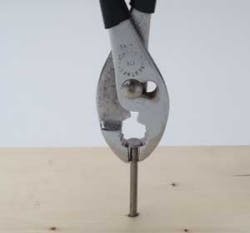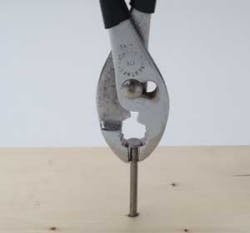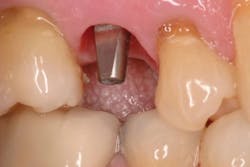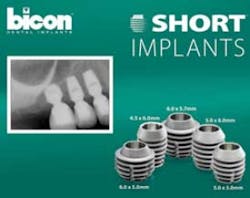Predictable, atraumatic dental extractions
By Anthony Feck, DMD
For more on this topic, go to www.dentaleconomics.com and search using the following key words: exodontia, dental extractions, atraumatic, lever, Tony Feck, DDS, Physics Forceps.
New paradigms in dentistry
When I take stock of how dentistry has changed during my career, I marvel at how different the profession is now versus when I began practice in 1983. Even all these years later, I continue to discover new ways to do old things. For the most part, these new methods are a significant improvement. Less commonly, a new method comes along that calls for a drastically different way of looking at a procedure.
Can you relate?
Dentists, by nature, are control freaks. We feel the more control we have, the more predictable the outcome, and nothing causes more anxiety in our professional lives than unpredictability. See if you can relate to this example:
It's early in the afternoon at your office. Your scheduling coordinator has placed an emergency patient into a 50-minute opening in your schedule. By the time you've evaluated this 45-year-old patient and determined he has a painful, badly broken down, periodontally healthy, yet nonsalvageable maxillary first molar, you have 15 minutes left in the appointment.
At this point, you have three options – refer the patient to a specialist, reappoint the patient when you have more time, or tackle the extraction now. This should be an easy decision given that the last option is the only one that has the potential to directly add to today's bottom line – not an insignificant consideration these days.
However, it's not an easy decision. You know an extraction like this can take five minutes if it's uncomplicated, or 20 minutes if you use a surgical approach. You also know that if you break a root tip or run into some other challenges along the way, you could be with the patient for an hour or more. All of this uncertainty means stress for you. So what do you do?
If you've ever experienced anything like this scenario, or heard that sickening sound of a root breaking in the middle or apical third, then I have very good news for you, and the closest thing to a guarantee that you will ever hear in dentistry.
By changing the way you extract teeth, you can predictably remove any erupted tooth in five minutes or less! And, you can do it atraumatically, resulting in less anxiety and less tissue damage. Less tissue damage means hard and soft tissue is conserved.
What sounds too good to be true is simply applying principles of physics to create a mechanical advantage, and applying principles of biochemistry to break down the periodontal ligament.
Leveraging yourself
We use simple machines to make our work more efficient and effective. There are six types of simple machines – inclined plane, pulley, screw, wedge, wheel and axle, and lever. In exodontia, we use levers to create a mechanical advantage.
A lever is a rigid object used with an appropriate fulcrum or pivot point to multiply the mechanical force (effort) that can be applied to another object (load). This action can be even more effective by taking advantage of the Principle of Moments – the greater the moment, the greater the mechanical advantage.
A moment can be expressed mathematically by the equation M=Fd, where M is the moment or torque, F is the force applied, and d is the distance between the force and the fulcrum. This equation tells us that if we increase the distance between the application of force and the pivot point (fulcrum), then we increase the mechanical advantage. Now let's look at how this applies to exodontia.
Traditional extraction techniques use a combination of severing the periodontal attachment, luxation with an elevator, and removal with forceps. If the elevator fails to cause noticeable separation of the tooth from the socket, the forceps accomplish the work through intermittent apical and lateral forces. If the tooth is already weakened from endodontic treatment or decay, or if the roots are long and/or dilacerated, then traditional extraction forceps often cause fracture of the tooth, surrounding bone, or both. This can lead to a more involved surgical approach, accompanied by corresponding undesirable postoperative sequelae.
For decades dentists have lamented, "There has to be a better way." While usually effective, traditional exodontia is akin to removing a nail from a board with a pair of pliers. Trying to do so places the operator at a mechanical disadvantage, one that worsens with the length of the nail embedded in the board, and worsens even more if the embedded portion is bent. Attempting this inevitably takes more time and creates more damage.
Based on what we know about levers and moments, the force being applied in this case is at the fulcrum, meaning there is a very short distance between force and fulcrum (essentially none).
A more effective class I lever is created when we use a claw hammer to remove the nail. In this case, the force applied to the object (nail) is farther away from the fulcrum (the base of the hammer), creating a greater moment or mechanical advantage, resulting in more efficient removal of the nail.
What happens if we take what we know about the principles of levers, along with theanalogy of the hammer and nail, and compare that to the method of extracting teeth? Traditional extraction forceps are like the pliers in the example. The location of the force application and the fulcrum are the same.
An inordinate amount of force is required, and the risk of something breaking is increased. The traditional elevator is a somewhat better class I lever than the traditional forceps in that there is some distance between the force of application and the fulcrum.
What if we increased that distance even more? The designers of the Physics ForcepsTM (Golden-Misch) incorporated this concept into the design of their instruments.
With these forceps the force is applied on the lingual root surface, while the fulcrum is moved to the buccal side and positioned in the vestibule near the apex of the roots, which translates into more force generated per unit of effort. Still, the magnitude of the force is only part of the story behind this new paradigm in exodontia.
Pacing yourself
During the extraction of a tooth, the dental alveolar bone surrounding the socket expands and the periodontal ligament is severed. While these physical changes undoubtedly occur, biochemical changes also occur that are arguably more important. When the periodontal ligament is traumatized with forceps or elevators, hyaluronidase is released.
This enzyme catalyzes the hydrolysis of hyaluronic acid, which comprises a substantial portion of the extracellular matrix of all human tissue, including the periodontal ligament. Once the chemical breakdown of the periodontal ligament by hyaluronidase is sufficient, the tooth is released from its attachment to the alveolus and can be easily removed.
The more hyaluronidase released per unit time, the more efficient the release of the tooth, and the less trauma there is to the alveolar bone. This explains why the Physics Forceps (Golden-Misch), with its steady, unrelenting pressure on the periodontal ligament, quantitatively creates a greater release of hyaluronidase in a shorter period of time than traditional forceps or elevator extractions, because the trauma from those techniques is intermittent.
Six steps to predictable, atraumatic extractions
- With the patient adequately anesthetized, the periodontal attachment of the tooth slated for extraction is severed with a soft tissue curette or similar instrument.
- (Optional) In the case of mandibular molars, sectioning of the tooth into a mesial and distal portion can be helpful. In those instances where lingual tooth structure is badly broken down, a flame-shaped diamond bur can be used to cut a "trough" in the alveolar bone to expose sound lingual tooth structure in order to gain a purchase.
- The appropriate Physics Forceps is chosen. There are four standard instruments (upper anterior, upper right, upper left, lower universal), and four second/third molar instruments (upper right, upper left, lower right, lower left). A "bumper" is placed on the buccal portion of the forceps. This cushions the light pressure placed on the alveolar mucosa.
- The lingual beak is placed on the lingual surface against sound tooth structure, while the buccal portion is placed against the mucosa at the approximate level of the mucogingival junction.
- Light, constant, rotational pressure around the axis of the tooth is applied.
- Within a short period of time, movement of the tooth laterally and/or occlusally will be noticed. This will continue until the tooth is mobile enough to remove with a rongeur or traditional forceps. The Physics Forcep is not meant to completely remove the tooth from the socket, but to sever the attachment to the socket so that it can be easily removed. This prevents fracture of the buccal plate of bone.
Making exodontia easier
Exodontia can be a fast, predictable, and atraumatic procedure for the patient and dental team. Many practitioners are using a new process that takes advantage of efficient Class I lever principles, as well as biochemical properties that result in the release of the tooth from the socket while conserving bone and soft tissue. The technique described uses the Physics Forceps by Golden-Misch (www.PhysicsForceps.com) that are relatively easy to use and master.
Dr. Anthony Feck practices in a multi-doctor practice in Lexington, Ky., that concentrates on sedation, comprehensive rehabilitation, and dental-facial cosmetics. He is the cofounder and dean of faculty for DOCS Education (www.DocsEducation.com), teaching dentists and their teams to safely and effectively treat high-fear patients with conscious sedation. Dr. Feck is the founder of Sunrise Dental Solutions (www.SunriseDentalSolutions.com), a comprehensive consulting company. Reach him at [email protected].
Past DE Issues



